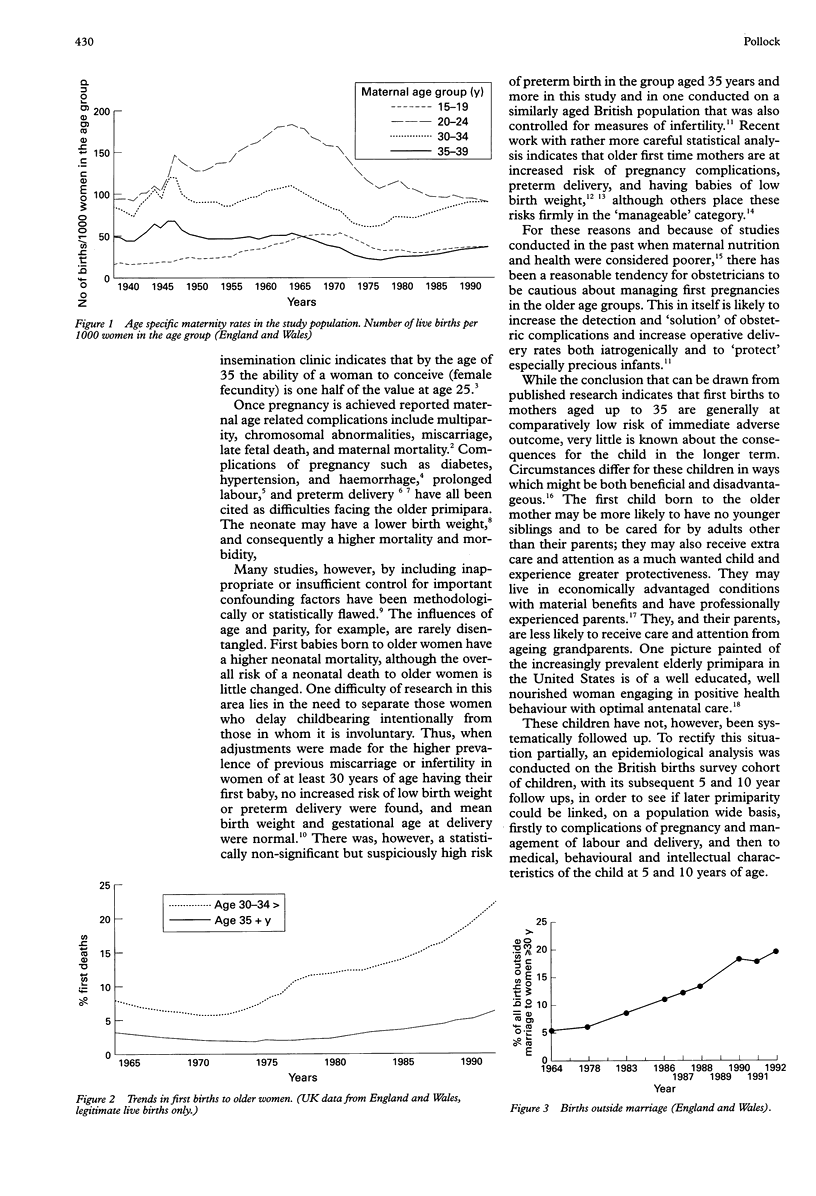Abstract
STUDY OBJECTIVES: To identify the physical, behavioural, medical, and educational outcomes in first children born to women aged 30 or more compared with those born to younger women. DESIGN: Longitudinal cohort study design employing logistic regression analysis of data obtained from the British births survey of 1970 and the child health and education study follow ups to this cohort at ages 5 and 10. SETTING: One week birth cohort covering the whole of the United Kingdom. PARTICIPANTS: The carers of 4315 first children born to women during the week of April 5th-11th 1970 inclusive in the whole of the United Kingdom except Northern Ireland, and followed up at both 5 and 10 years of age. In addition, information was obtained from health visitors, the child's teacher at 10, and the medical officer who completed an examination. At 10 the child also completed a questionnaire. MEASUREMENTS: Data were obtained from questionnaires administered to the carers of the child at each time point, from their teacher at age 10, and from the results of a medical examination at age 10. Educational tests were also conducted at this age. MAIN RESULTS: Having adjusted for the effects of confounding factors, late primiparity was significantly associated with a number of events in labour and delivery involving obstetric interventions ranging from induction to operative deliveries and general anaesthesia. At 5 years of age, controlling additionally for family size at that time, associations were found between late primiparity and fewer adverse measures of behaviour in the child. Both the child's head circumference and the score on a picture based vocabulary test at this age were slightly greater in the index group. At 10 years of age, adjusting for background factors and present family size, late primiparity was associated with few outcome measures. Children born to older mothers, however, scored slightly higher on a broad range of educational tests administered at school. CONCLUSIONS: No clearly demonstrable adverse outcomes could be linked to later primiparity in the 1970 child health and education study national cohort study. Modest behavioural and educational advantages were detected in the group with older first-time mothers. A woman's later primiparity may be associated with their child having a slightly larger head circumference compared with whole of the rest of the study cohort.
Full text
PDF






Images in this article
Selected References
These references are in PubMed. This may not be the complete list of references from this article.
- Aldous M. B., Edmonson M. B. Maternal age at first childbirth and risk of low birth weight and preterm delivery in Washington State. JAMA. 1993 Dec 1;270(21):2574–2577. [PubMed] [Google Scholar]
- BOOTH R. T., WILLIAMS G. L. ELDERLY PRIMIGRAVIDAE. J Obstet Gynaecol Br Commonw. 1964 Apr;71:249–254. doi: 10.1111/j.1471-0528.1964.tb04274.x. [DOI] [PubMed] [Google Scholar]
- Barkan S. E., Bracken M. B. Delayed childbearing: no evidence for increased risk of low birth weight and preterm delivery. Am J Epidemiol. 1987 Jan;125(1):101–109. doi: 10.1093/oxfordjournals.aje.a114491. [DOI] [PubMed] [Google Scholar]
- Berkowitz G. S., Skovron M. L., Lapinski R. H., Berkowitz R. L. Delayed childbearing and the outcome of pregnancy. N Engl J Med. 1990 Mar 8;322(10):659–664. doi: 10.1056/NEJM199003083221004. [DOI] [PubMed] [Google Scholar]
- Brennan T. L., Funk S. G., Frothingham T. E. Disproportionate intra-uterine head growth and developmental outcome. Dev Med Child Neurol. 1985 Dec;27(6):746–750. doi: 10.1111/j.1469-8749.1985.tb03798.x. [DOI] [PubMed] [Google Scholar]
- Cnattingius S., Forman M. R., Berendes H. W., Isotalo L. Delayed childbearing and risk of adverse perinatal outcome. A population-based study. JAMA. 1992 Aug 19;268(7):886–890. [PubMed] [Google Scholar]
- Cohen W. R., Newman L., Friedman E. A. Risk of labor abnormalities with advancing maternal age. Obstet Gynecol. 1980 Apr;55(4):414–416. [PubMed] [Google Scholar]
- Forman M. R., Meirik O., Berendes H. W. Delayed childbearing in Sweden. JAMA. 1984 Dec 14;252(22):3135–3139. [PubMed] [Google Scholar]
- Frankel S. A., Wise M. J. A view of delayed parenting: some implications of a new trend. Psychiatry. 1982 Aug;45(3):220–225. doi: 10.1080/00332747.1982.11024152. [DOI] [PubMed] [Google Scholar]
- Grimes D. A., Gross G. K. Pregnancy outcomes in black women aged 35 and older. Obstet Gynecol. 1981 Nov;58(5):614–620. [PubMed] [Google Scholar]
- Harker L., Thorpe K. "The last egg in the basket?" elderly primiparity--a review of findings. Birth. 1992 Mar;19(1):23–30. doi: 10.1111/j.1523-536x.1992.tb00368.x. [DOI] [PubMed] [Google Scholar]
- Ounsted M., Moar V. A., Scott A. Associations between size and development at four years among children who were small-for-dates and large-for-dates at birth. Early Hum Dev. 1984 Apr;9(3):259–268. doi: 10.1016/0378-3782(84)90036-7. [DOI] [PubMed] [Google Scholar]
- Roberts C. L., Algert C. S., March L. M. Delayed childbearing--are there any risks? Med J Aust. 1994 May 2;160(9):539–544. [PubMed] [Google Scholar]
- Tuck S. M., Yudkin P. L., Turnbull A. C. Pregnancy outcome in elderly primigravidae with and without a history of infertility. Br J Obstet Gynaecol. 1988 Mar;95(3):230–237. doi: 10.1111/j.1471-0528.1988.tb06862.x. [DOI] [PubMed] [Google Scholar]
- Ventura S. J. First births to older mothers, 1970-86. Am J Public Health. 1989 Dec;79(12):1675–1677. doi: 10.2105/ajph.79.12.1675. [DOI] [PMC free article] [PubMed] [Google Scholar]
- Welles-Nyström B. L., de Château P. Maternal age and transition to motherhood: prenatal and perinatal assessments. Acta Psychiatr Scand. 1987 Dec;76(6):719–725. doi: 10.1111/j.1600-0447.1987.tb02945.x. [DOI] [PubMed] [Google Scholar]
- van Noord-Zaadstra B. M., Looman C. W., Alsbach H., Habbema J. D., te Velde E. R., Karbaat J. Delaying childbearing: effect of age on fecundity and outcome of pregnancy. BMJ. 1991 Jun 8;302(6789):1361–1365. doi: 10.1136/bmj.302.6789.1361. [DOI] [PMC free article] [PubMed] [Google Scholar]



